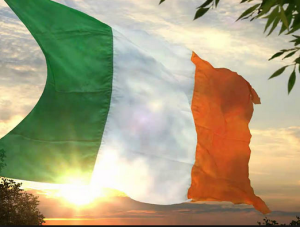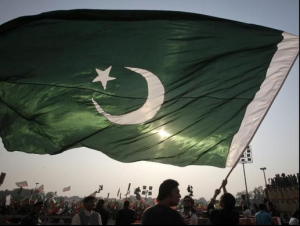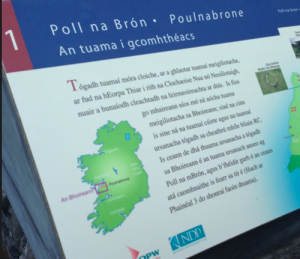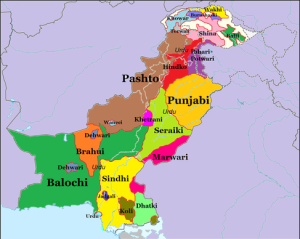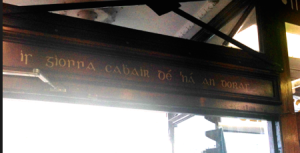Ireland and Pakistan aren’t ever really thought of in the same category. However, many fail to realize that both countries have more in common than what meets the naked eye. Both countries were conquered by England at one point, and faced a brutal partition afterward. Additionally, both countries have their own respective native languages which still exist to some extent. After English colonization, the English language was present, if not prominent in each nation. One of Pakistan’s official languages is English, and in Ireland, the English language dominants the entire country: only leaving a small percentage of those who learn and speak Gaelic today. Nonetheless, the presence of the Irish Gaelic language still exists in Ireland today-just as Urdu still exists in Pakistan.
Above: The Irish flag and the Pakistani flag, respectively.
Above: A sign to Nun’s Island in Galway, Ireland. Most, if not all signs in Ireland contain information in both Irish Gaelic and English.
Above: Information on The Burren, written in Irish Gaelic.
Background/History of the Irish Gaelic Language:
Also spreading to Scotland, the Irish Gaelic language has been present since before 300 BC. The first evidence of the language was written on stones. This is called Ogham, a form of writing using notches or strokes. Containing only eighteen letters in its alphabet, the language dominated Ireland for hundreds of years until the Anglo-Norman conquest in 1601. There are three dialects of Irish Gaelic: Ulster Irish Gaelic, Connacht Irish Gaelic, and Munster Irish Gaelic. The language was even once known as a “political subversion” (Margaret B. Sutherland), and was characterized as a barbarian language by the English. The language was still spoken by Irish natives, but with the Irish Penal Laws, plantation systems and other restrictions it ended up dying out. The English language took over, and is debated as Ireland’s “mother tongue” nowadays. Today, very few people speak or understand Irish Gaelic (though the dialects do still exist today). Typically, Irish Gaelic is really only spoken at home in certain areas of Ireland (see map below). Despite an Irish Gaelic revival in the early 2000s, the language still isn’t spoken all too commonly. It is mandatory for students to learn Irish Gaelic in primary school, though many students dread it and do not retain their knowledge of it. Additionally, several Gaelic-only speaking schools exist in Ireland, in which parents can send their child to if they wish.
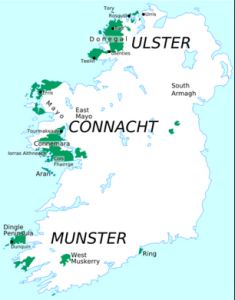 *Green areas indicate a presence of the Irish Gaelic language.
*Green areas indicate a presence of the Irish Gaelic language.
Learn some Gaelic:
Background/History of Urdu:
A language evolving from Farsi and Arabic, Urdu emerged around 711 in the Sindh Province of what is now modern day Pakistan. Urdu contains thirty-eight letters in its alphabet, with no proper uppercase or lowercase. The Persian and Turk invasion of the Indian subcontinent urged those who spoke Hindi and those who spoke Arabic to merge the language together, ultimately forming Urdu. However, Urdu was not fully developed and commonly spoken until the rise of the Mughal Empire in 1526. Nowadays, Urdu is one of Pakistan’s seven official languages. Generally speaking, Urdu is spoken all over Pakistan. However, certain areas, such as the Sindh province have a higher concentration of those who speak the language. Below illustrates a map of where Urdu, along with several other languages in Pakistan, is spoken:
Learn some Urdu:
Similarities between Irish Gaelic and Urdu:
Surprisingly, there are some similarities between Irish Gaelic and Urdu. As mentioned in the videos above, a greeting in Gaelic is “Dia is Muire dit,” meaning “God and Mary to you.” In Urdu, the greeting for saying “Hello” is “Asalaam o’alaikum,” meaning “Peace be unto you.” Although the meaning isn’t exactly the same, it is obvious that both Gaelic and Urdu have religious undertones in their language. Similarly, counting numbers sound somewhat similar in Irish as it does in Urdu. It isn’t as strikingly similar as some of the Romantic languages (as mentioned in the video above), but certain vowels and short syllables show a resemblance:
Irish Gaelic, 1-10:
Urdu, 1-10 (start at 0:30 seconds) :
Clearly, there are some striking similarities between Irish Gaelic and Urdu. Nonetheless, languages will also differ in comparison, too.
Differences between Irish Gaelic and Urdu:
Historical/Societal Differences:
Irish Gaelic and Urdu both sound pretty different when it comes to sentences coming together. Also, Irish Gaelic is much older than Urdu. Urdu was not founded until 711, and it didn’t fully develop until 1206. Additionally, Urdu didn’t become a very popular language until the establishment of the Mughal Empire in 1526. Nowadays, Urdu is considered one of Pakistan’s official languages, and is still spoken commonly in the country. Although the English language is also present in Pakistan (and is considered one of Pakistan’s official languages), it is not as commonly spoken as it is in Ireland. In fact, English is really only studied/spoken by the upper-class in Pakistan, or those who have access to higher education. On the contrary, some may argue that Ireland’s mother tongue is now English instead of Irish Gaelic.
Pronunciation/Structural Differences:
Additionally, each language has incredibly different pronunciations. In old Irish Gaelic, “broad” vowels are a, o, and u. “Slender” vowels would be the letters e and i. According to Annie Loughlin from Gaol Naofa (an organization committed to learning about Gaelic culture), the vowels sound like this:
a — in the first syllable of a word, it is lengthened, as in farther (or rather, if you have a posh English accent!)
a — in the second syllable of a word, it is a shortened sound, as in woman
o — a short sound, as in hot
u — a short sound, as in put
e — in the first syllable of a word, a short sound as in pet
e — in the second (and subsequent) syllable of a word, as in mother
i — a short sound, as in sit, but the sound can be changed by other vowels next to it
. There are seven vowels in Urdu, which according to BBC, sound like this:
The ‘a’ in ‘father’
The ‘ee’ in ‘seed’
The ‘oo’ in ‘boot’
The ‘o’ in ‘order’
The ‘au’ in ‘Australia’
The ‘e’ in ‘help’
The ‘a’ in ‘apple’
And the “short vowels” in Urdu sound like this:
The ‘a’ in the English word ‘about’
The ‘i’ in ‘bin’
The ‘u’ in ‘put’
(BBC)
Clearly, there is a large difference in pronunciation between each language. Urdu and Irish Gaelic do have accents or symbols which can alter the way certain words or letters are pronounced, just they differ in the script that they are written and how they are interpreted.
My experience with the Gaelic language in Ireland:
Generally speaking, I wasn’t able to find too many people who spoke Gaelic when I went to Ireland. When I asked, most cringed at the thought of speaking it an described it as their toughest subject to learn in primary school. However, I was able to talk to two people who spoke some Gaelic. One man was a shopkeeper in Sligo, and he was fluent in Gaelic (Connacht dialect). Although his father spoke no Gaelic, his grandfather did, which is from who he learned. He was thrilled to report that both of his grandchildren were enrolled in a Gaelic-only speaking school, so they would be fluent in the language. I asked him why most people in Ireland seemed to cringe when I asked them about when they learned Gaelic. His response was that those who do not enjoy learning about the Gaelic language most probably had it taught poorly to them. He believed that a good teacher would enable most students to actually enjoy the Gaelic language, which I believe can go for all subjects in the academic world. He then showed me what the inscription above the door of his shop meant:
The phrase here means that “God’s help is closer than the door,” a phrase to encourage prayer or to restore faith in God.
I was very grateful for the experience I had in Ireland and hope to visit again, next time maybe even trying some Gaelic myself.
References
BBC. “The History of Irish Gaelic.” BBC. 29 October 2014. Web. 22 Aug 2015. <http://www.bbc.co.uk/voices/multilingual/irish_history.shtml>
BBC. “A Guide to Urdu.” BBC. 2014. Web. 22 Aug. 2015. <http://www.bbc.co.uk/languages/other/urdu/guide/alphabet.shtml>
Loughlin, Annie. “A Beginner’s Guide to Old Irish Pronunciation.” Gaol Naofa. 2015. Web. 22 Aug. 2015. <http://www.gaolnaofa.org/articles/a-beginners-guide-to-old-irish-pronunciation/>
MacLeod, Michelle. “The Plight of Three Celtic Languages–Welsh, Irish and Gaelic.” Scottish Language 29 (2010): 91+. Academic OneFile. Web. 22 Aug. 2015.
Sutherland, Margaret B. “Problems of Diversity in Policy and Practice: Celtic Languages in the United Kingdom.” Comparative Education. Volume 36, No. 2. pgs 199-209. May 2000.
Oideas Gael. “Language and Culture Summer School.” Oideas Gael. 2012. Web. 22 Aug. 2015. <http://www.oideasgael.ie/en/language-and-culture-summer-school/>
WDC (World Digital Library), Govt. College Lahore. “The History of the Urdu Language.” World Digital Library. 11 May 2015. Web. 22 Aug. 2015. <http://www.wdl.org/en/item/9700/>

